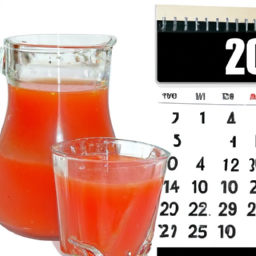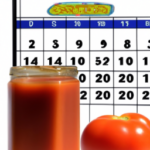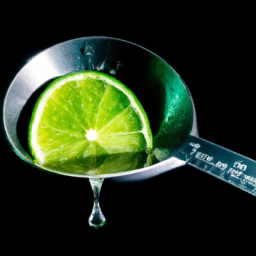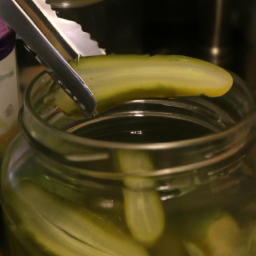As someone who enjoys a good glass of tomato juice, I often find myself wondering about how long this delicious drink will last in my fridge. The last thing I want is to drink spoiled juice and risk getting sick.
So, I did some research and found out that the shelf life of tomato juice varies depending on several factors, but there are ways to extend its freshness and ensure its safety.
First and foremost, it’s important to understand that tomato juice is a perishable item and can only last so long before it starts to spoil. Generally, an unopened bottle or can of tomato juice can last up to 12 months when stored in a cool, dry place away from direct sunlight. However, once opened, the juice should be consumed within 4-7 days when kept in the fridge at a temperature of 40°F or below.
In this article, I will delve deeper into the factors that affect tomato juice shelf life and provide tips on how to properly store, freeze, and extend the freshness of this beloved beverage.
Key Takeaways
- Opened tomato juice should be consumed within 4-7 days when refrigerated at 40°F or below.
- Proper storage techniques such as refrigeration, airtight containers and temperature control can extend the shelf life.
- Homemade tomato juice lasts up to 5 days in the fridge, while store-bought juice can last up to 7 days.
- Freezing tomato juice can extend the shelf life up to 6 months.
Understanding Tomato Juice Shelf Life
Don’t waste your money on spoiled tomato juice – know how long it stays good in the fridge! Understanding the shelf life of tomato juice is essential in maximizing its freshness and preventing spoilage. The shelf life of tomato juice varies depending on factors such as temperature, air exposure, and the quality of the juice.
Typically, unopened tomato juice can last up to 18 months in the pantry at room temperature. However, once opened, its shelf life decreases significantly. In the fridge, opened tomato juice can last for up to 7 days before it starts to spoil. Therefore, it’s essential to consume it within a week of opening it to avoid unnecessary waste.
Proper storage techniques such as storing it in an airtight container and refrigerating it at a temperature of 40°F or below can help extend its shelf life.
Without storing tomato juice properly, it can quickly become a breeding ground for bacteria. In the next section, we’ll discuss the proper storage techniques in detail to help you keep your tomato juice fresh for a more extended period.
Proper Storage Techniques
When it comes to properly storing tomato juice, there are a few key points to keep in mind.
First and foremost, temperature control is crucial. Tomato juice should always be stored in the refrigerator at a temperature of 40°F or below to prevent spoilage.
Additionally, it’s important to use airtight containers to help maintain freshness and avoid exposure to air.
Finally, to prevent cross-contamination, make sure to keep tomato juice separate from other foods in the refrigerator.
By following these techniques, you can ensure that your tomato juice stays fresh and safe to consume.
Temperature Control
To maintain optimal freshness, you should ensure that your tomato juice is stored at a consistently cool temperature in the fridge. The effects of temperature on the spoilage prevention of tomato juice can’t be overstated.
Here are some reasons why you should keep your tomato juice at a cool temperature:
-
High temperatures can cause the growth of bacteria in tomato juice, leading to spoilage and possible food poisoning.
-
Keeping tomato juice at a cool temperature slows down the chemical reactions that lead to spoilage, prolonging its shelf life.
-
Heat can cause the breakdown of nutrients in tomato juice, reducing its nutritional value.
-
Warm temperatures can cause the juice to lose its taste and flavor, making it unappetizing.
Therefore, it’s important to ensure that your tomato juice is stored at a consistently cool temperature in the fridge to prevent spoilage and maintain its quality.
Moving on to the next topic, airtight containers are also essential for preserving the freshness of tomato juice.
Airtight Containers
Using an airtight container for storing your tomato juice is like sealing a treasure chest full of gems, keeping the precious freshness locked in for days to come. Airtight containers are designed to prevent air from entering and exiting the container, creating a sealed environment that maintains the quality of the contents. This is particularly important for tomato juice, as exposure to air can cause the juice to spoil quickly. By using an airtight container, you can extend the shelf life of your tomato juice by several days, allowing you to enjoy it for longer.
When it comes to choosing the best airtight container for your tomato juice, there are several factors to consider. Look for containers that are made from high-quality materials, such as glass or BPA-free plastic. These materials are less likely to react with the acid in the tomato juice, preserving its flavor and freshness. Some of the best brands for airtight containers include Rubbermaid, Pyrex, and OXO. These brands are known for their durability and reliability, ensuring that your tomato juice stays fresh for as long as possible.
Transitioning into the subsequent section about avoiding cross-contamination, it is important to handle your airtight container with care to prevent the spread of harmful bacteria.
Avoiding Cross-Contamination
Preventing the spread of harmful bacteria is crucial in maintaining the quality of your freshly stored tomato juice, so it’s important to handle your airtight container with care. One way to prevent bacteria growth is to use separate utensils when handling your tomato juice. This will prevent cross-contamination from other foods or surfaces.
Additionally, always remember to wash your hands and utensils thoroughly before handling your tomato juice. Another important factor in preventing bacteria growth is cleaning your airtight container regularly. Make sure to use a mild soap and hot water to clean the container thoroughly before and after each use.
To avoid any residual soap, rinse the container with hot water several times before drying it completely. Proper cleaning procedures will not only prevent bacteria growth but also help maintain the taste and quality of your tomato juice.
When it comes to freezing tomato juice, there are a few important steps to follow to ensure its quality.
Freezing Tomato Juice
If you’re looking for a way to extend the shelf life of your tomato juice, freezing it is a great option. Not only does it allow you to enjoy your juice for a longer period of time, but it also preserves its nutritional value. Freezing tomato juice is also a great way to have it on hand for creative recipes that call for tomato juice.
To freeze tomato juice, simply pour it into a freezer-safe container, leaving about an inch of space at the top to allow for expansion. Seal the container tightly and label it with the date. Tomato juice can be safely stored in the freezer for up to 6 months. When you’re ready to use it, simply thaw it in the refrigerator or at room temperature and give it a good stir before drinking or using in recipes.
Extending the shelf life of tomato juice can be done in a variety of ways, including freezing and refrigeration. However, there are also other methods that can be used to keep your tomato juice fresh for longer.
Extending Tomato Juice Shelf Life
To maximize the freshness of your tomato juice, you’ll want to store it in an airtight container and keep it in the coldest part of your refrigerator. This will help slow down the growth of bacteria and prevent spoilage.
In addition, there are a few other things you can do to extend the shelf life of your tomato juice:
- Add a pinch of salt to the juice before storing it. Salt helps to inhibit the growth of bacteria and can help your juice stay fresh for a few extra days.
- Store your tomato juice in smaller containers. The more air that’s in the container, the faster the juice will spoil. By dividing it into smaller containers, you’ll reduce the amount of air in each one and help keep your juice fresher for longer.
- Use a vacuum sealer to remove as much air as possible before storing your juice. This will help to preserve the flavor and nutrients of your juice and extend its shelf life even further.
By following these tomato juice preservation tips, you’ll be able to enjoy your juice for longer without worrying about it going bad. Now, let’s move on to the next section and learn how to make tomato juice at home.
Making Tomato Juice at Home
When I make tomato juice at home, I always make sure to choose the right type of tomatoes. Plum tomatoes are ideal for juicing because they have fewer seeds and less water content.
Once I have my tomatoes, I prepare them by washing and cutting them into quarters before blending them into a smooth consistency.
To store homemade juice, I pour it into airtight containers and refrigerate it for up to 5 days.
Choosing the Right Tomatoes
You’ll want to pick the ripest tomatoes you can find for the best-tasting juice – think juicy red orbs bursting with flavor! When it comes to making tomato juice, the growing process and types of tomatoes used can make a significant difference in taste. Tomatoes that are vine-ripened have a sweeter taste and are more flavorful than those that are picked early and left to ripen off the vine.
To ensure that your tomato juice has the best possible taste, consider using high-quality tomatoes such as Roma or San Marzano tomatoes. These types of tomatoes are meatier and have fewer seeds, making them ideal for juicing. Additionally, they have a rich, sweet flavor that is perfect for tomato juice.
When it comes to preparing and blending your tomato juice, it’s important to keep in mind the shelf life of the juice. Speaking of which, have you ever wondered how long tomato juice is good for in the fridge?
Preparing and Blending
Now it’s time to blend up your delicious tomato juice and savor the fresh, summery flavors in every sip. To start, make sure you have a high-speed blender that can handle the thick consistency of the tomatoes.
Cut your prepared tomatoes into small chunks and add them to the blender. It’s important to blend them thoroughly to get a smooth consistency, so blend for at least 1-2 minutes or until the mixture is completely smooth.
When it comes to flavor variations, you can add different herbs and spices to your tomato juice to give it a unique taste. Some popular additions include basil, garlic, celery, and jalapeño peppers. Just make sure to add them in small amounts and taste as you go to avoid overpowering the natural tomato flavor.
Once your juice is blended to perfection, it’s time to move on to storing it in the fridge for later use.
Transition: Now that you’ve blended your tomato juice, it’s important to know how to properly store it in the fridge to ensure it stays fresh.
Storing Homemade Juice
Don’t worry about your homemade juice spoiling quickly, as there are simple steps you can take to extend its freshness and flavor. Juice preservation starts with proper storage, which means keeping your juice in airtight containers, such as glass bottles or jars, and storing them in the refrigerator. This will help prevent oxidation and microbial growth, which are the main factors that cause spoilage.
Homemade juice storage is essential for maintaining the quality and freshness of your homemade juice. It is important to note that homemade juice does not have the same preservatives as store-bought juice, so it has a shorter shelf life.
Generally, homemade tomato juice can last for up to 5 days in the refrigerator, but it’s best to consume it as soon as possible to enjoy its full flavor and nutritional benefits.
The next section will discuss the importance of freshness and quality when it comes to homemade juice.
Importance of Freshness and Quality
When it comes to buying juice, freshness and quality are essential. I always make sure to check the expiration dates before purchasing any juice.
It’s also important to avoid buying juice that appears or smells spoiled.
Buying Fresh Juice
You should always check the expiration date before buying fresh tomato juice. It’s important to ensure that the juice is still within its shelf life to avoid consuming spoiled or contaminated products.
Tomato juice is typically purified before being bottled, which removes any impurities or bacteria. This process ensures that the juice is safe to consume but doesn’t extend its shelf life beyond the expiration date.
In addition to ensuring the safety of the juice, checking the expiration date also helps you get the most nutritional benefits from the juice. Fresh tomato juice is rich in vitamins and minerals, such as vitamin C and potassium, that are essential for maintaining a healthy diet.
However, the longer the juice sits on the shelf, the more the nutritional value decreases. By checking the expiration date and buying the freshest juice possible, you can ensure that you’re getting the maximum nutritional benefits from your tomato juice.
So, make sure to always check the expiration date before buying fresh tomato juice and enjoy the many health benefits that it provides.
Checking Expiration Dates
Make sure to always check the expiration date on products before purchasing to ensure their quality and freshness. This is especially important for perishable items, such as dairy products, meat, and fresh produce. If you notice that the expiration date is close, it’s best to avoid buying the product altogether.
Expiration dates serve as a guide for consumers to determine the shelf life of a product, and consuming expired items can lead to food poisoning, illness, or even death.
When it comes to storing perishable items in the fridge, there are some best practices to keep in mind. First, make sure to store items at the appropriate temperature. The fridge should be set to 40°F or below to prevent the growth of bacteria.
Additionally, it’s important to store food in airtight containers or wrap them tightly to prevent odors from spreading and to keep the food fresh for longer. Finally, be sure to regularly clean out the fridge to avoid the growth of mold and other bacteria.
By following these guidelines, you can ensure that your food stays fresh and safe to eat, including your tomato juice.
To avoid spoiled juice, there are a few extra steps you can take.
Avoiding Spoiled Juice
In the previous section, we talked about checking expiration dates to ensure that we consume safe and fresh tomato juice. However, there are other ways to avoid spoiling the juice and preventing waste. One of the most effective ways is to store the juice properly in the fridge.
To prevent waste and minimize spoilage, it is important to understand how long tomato juice can last in the fridge. According to the United States Department of Agriculture (USDA), an opened can or bottle of tomato juice can last for 5 to 7 days when stored in the refrigerator at or below 40°F. However, if the juice has been exposed to air or contaminated with food particles, it may spoil earlier than that. Therefore, it is important to seal the container tightly and avoid exposing it to air.
To illustrate the recommended storage time for tomato juice in the fridge, here is a table that summarizes the information from the USDA:
| Type of Tomato Juice | Storage Time in the Fridge |
|---|---|
| Canned | 5-7 days |
| Bottled | 5-7 days |
| Homemade | 2-4 days |
By following these guidelines, you can avoid waste and minimize spoilage, ensuring that you can consume fresh and safe tomato juice every time. In the next section, we will discuss the health benefits of tomato juice.
Health Benefits of Tomato Juice
The health benefits of tomato juice are numerous. Did you know that just one cup provides over 40% of your daily recommended intake of vitamin C? In addition to this, tomato juice is also a great source of vitamin A, potassium, and antioxidants. These nutrients together help boost your immune system, improve your skin health, and reduce the risk of chronic diseases.
To reap the full nutritional value of tomato juice, try incorporating it into your diet in different ways. Here are three recipe ideas to get you started:
-
Tomato Juice Smoothie: Blend tomato juice with your favorite fruits and vegetables for a nutritious and refreshing smoothie.
-
Tomato Juice Gazpacho: This cold soup is perfect for a hot summer day and is made with tomato juice, cucumbers, peppers, and other fresh ingredients.
-
Tomato Juice Salad Dressing: Use tomato juice as a base for a healthy and flavorful salad dressing, mixed with olive oil, herbs, and spices.
Now that you know the nutritional benefits and some recipe ideas, let’s explore different ways to enjoy tomato juice.
Different Ways to Enjoy Tomato Juice
Get creative with how you savor this nutritious drink by trying it as a base for a zesty Bloody Mary cocktail or incorporating it into a savory marinade for your favorite meats.
Tomato juice cocktails are a popular choice, and there are many flavor variations that you can experiment with. Add some spice with a dash of hot sauce or Worcestershire sauce, or go for a sweeter twist by mixing in some pineapple or cranberry juice. You can also add a kick of alcohol with a shot of vodka or tequila, or keep it non-alcoholic with a splash of soda water.
Aside from cocktails, tomato juice can also be used to enhance the flavor of other dishes. Use it as a base for a homemade tomato sauce or soup, or mix it with some olive oil, garlic, and herbs for a delicious salad dressing. The possibilities are endless, and the best part is that tomato juice is both low in calories and high in nutrients, making it a healthy addition to any meal.
As you explore different ways to enjoy tomato juice, it’s important to remember some common mistakes to avoid. One of the most common is storing it improperly, which can lead to spoilage and a shorter shelf life. We’ll discuss this further in the next section.
Common Mistakes to Avoid
As someone who regularly consumes juice, I’ve learned that there are some common mistakes to avoid.
One mistake is leaving juice out at room temperature for too long, which can promote bacterial growth and spoilage.
Another mistake is using contaminated equipment, such as dirty juicers or cups, which can introduce harmful bacteria into the juice.
Lastly, it’s important not to ignore signs of spoilage, such as changes in color, odor, or taste, as consuming spoiled juice can lead to food poisoning and other health issues.
By avoiding these common mistakes, you can ensure that your juice is safe and enjoyable to drink.
Leaving Juice Out
If you forget to put your tomato juice in the fridge, it won’t last as long and you’ll end up wasting it. Leaving juice out at room temperature can lead to contamination risks and bacterial growth. This can cause the juice to spoil quickly and become unsafe for consumption.
Bacteria thrive in warm and moist environments, making it important to store tomato juice in a cool place. Once bacteria start to grow, it can be difficult to stop them from multiplying. This is why it’s essential to refrigerate your tomato juice as soon as possible after opening it. By doing so, you can extend its shelf life and prevent the growth of harmful bacteria.
In order to maintain the freshness and quality of your tomato juice, it’s important to use clean and uncontaminated equipment when handling it. This includes using clean glasses, utensils, and storage containers.
By taking these simple precautions, you can ensure that your tomato juice stays fresh and safe to drink for as long as possible.
Using Contaminated Equipment
Earlier, we discussed the potential risks of leaving tomato juice out for an extended period. However, there is another factor that can contribute to the spoilage of tomato juice: contaminated equipment.
As someone who enjoys making their own tomato juice at home, it’s essential to understand the importance of proper cleaning and sanitizing equipment to prevent contamination.
-
Proper cleaning: Before using any equipment, it’s crucial to clean it thoroughly to remove any dirt, debris, or residual tomato juice. This can be done using warm, soapy water and a non-abrasive sponge or cloth. It’s important to rinse the equipment thoroughly to remove any soap residue.
-
Sanitizing equipment: After cleaning, it’s necessary to sanitize the equipment to kill any bacteria or germs that may still be present. This can be done using a solution of one tablespoon of bleach per gallon of water, or by using commercial sanitizing products. It’s important to follow the manufacturer’s instructions when using these products.
-
Regular maintenance: To ensure that equipment remains clean and sanitary, it’s important to regularly inspect and clean it. This can be done after every use or at regular intervals, depending on how frequently the equipment is used.
By following these steps, you can reduce the risk of contamination and keep your tomato juice fresh for longer.
Neglecting to properly clean and sanitize equipment can not only lead to spoilage but also pose a health risk. In the next section, we’ll discuss the consequences of ignoring signs of spoilage.
Ignoring Spoilage Signs
You can’t ignore signs of spoilage in your homemade tomato juice, or else you’ll end up drinking a putrid concoction that could make you sick. Even if the tomato juice has been refrigerated, it can still go bad if it’s been sitting in the fridge for too long. Signs of spoilage can include a foul odor, a change in color, or the presence of mold. If you notice any of these signs, it’s best to throw the tomato juice away and not take any chances.
Consuming spoiled tomato juice can have negative effects on your health. The risks of consuming spoiled tomato juice include vomiting, diarrhea, and stomach cramps. In severe cases, it can even lead to food poisoning. To avoid these risks, it’s important to always pay attention to the signs of spoilage in your tomato juice and not consume it if there’s any doubt about its freshness. By taking these precautions, you can ensure that your homemade tomato juice is safe to drink and enjoy.
| Signs of Spoilage | What it Means |
|---|---|
| Foul Odor | The tomato juice has gone bad and should be thrown away. |
| Change in Color | The tomato juice has oxidized and may not taste as fresh. |
| Presence of Mold | The tomato juice is contaminated and should be thrown away. |
| Fizzing/Bubbling | The tomato juice has started to ferment and may not be safe to consume. |
Frequently Asked Questions
Can I mix tomato juice with other juices or liquids?
I can mix tomato juice with other juices or liquids, but there are pros and cons to consider. Tomato juice pairs well with vodka for a classic Bloody Mary, or with citrus juices for a refreshing twist. However, mixing with dairy or sweet juices may not be as appealing.
What are the best recipes for using tomato juice in cooking?
I love using tomato juice in cooking. It’s a versatile ingredient that can be used in many dishes. Tomato juice cocktails are a great way to enjoy it. It also works well as a marinade for chicken or beef.
Is it safe to drink tomato juice after the expiration date?
Drinking expired tomato juice can pose health risks due to bacteria growth, spoilage, and loss of nutrients. It is important to check the expiration date and discard if it has passed.
How can I tell if my tomato juice has gone bad?
I can tell if my tomato juice has gone bad by checking for signs of spoilage such as mold, off-odor, or discoloration. Its shelf life depends on factors like storage conditions and packaging, but generally lasts several months.
Can I store tomato juice in a plastic container instead of glass?
Plastic containers are suitable for storing tomato juice, but glass is preferred for long-term storage. Tomato juice can last up to 5 days in the fridge, regardless of the container.
Conclusion
Well, it turns out that tomato juice isn’t the immortal elixir we may have thought it was. Despite its health benefits and versatile uses, tomato juice has a limited shelf life in the fridge.
But fear not, with proper storage techniques and a little creativity, we can extend the life of our beloved tomato juice. As someone who loves to experiment with different recipes and ingredients, I’ve learned the hard way that freshness and quality are key when it comes to tomato juice.
It’s ironic that such a simple and ubiquitous ingredient can be so picky about its storage conditions, but that’s just the way it is. By following the tips in this article, we can ensure that our tomato juice stays fresh and tasty for as long as possible.
So go ahead, stock up on that tomato juice, and enjoy it in all its delicious forms!
Ilana has been a vegan for over 10 years. She originally made the switch for health reasons, but soon found herself becoming more and more passionate about the ethical and environmental implications of a vegan lifestyle. Ilana is the author of The Graceful Kitchen, a blog all about veganism. She loves to cook up delicious and nutritious vegan meals, and share her recipes with others who are interested in leading a cruelty-free life. Ilana is also a strong advocate for using whole foods as the foundation of a healthy diet, and believes that going vegan is one of the best ways to achieve this.
















